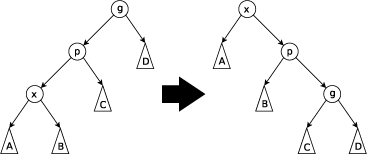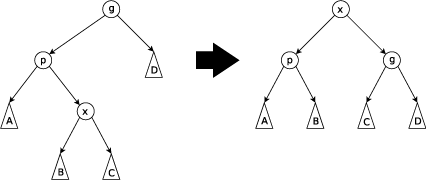伸展树
此條目需要补充更多来源。 (2022年9月18日) |
此條目可参照英語維基百科相應條目来扩充。 |
| 伸展树 | |||||||||||||||||||||
|---|---|---|---|---|---|---|---|---|---|---|---|---|---|---|---|---|---|---|---|---|---|
| 类型 | 树 | ||||||||||||||||||||
| 发明时间 | 1985年 | ||||||||||||||||||||
| 发明者 | 丹尼爾·斯萊托和羅伯特·塔揚 | ||||||||||||||||||||
| 用大O符号表示的时间复杂度 | |||||||||||||||||||||
| |||||||||||||||||||||
伸展树(英語:Splay Tree)是一种能够自我平衡的二叉查找树,它能在均摊的时间内完成基于伸展(Splay)操作的插入、查找、修改和删除操作。它是由丹尼爾·斯萊托和羅伯特·塔揚在1985年发明的[1]。
在伸展树上的一般操作都基于伸展操作:假设想要对一个二叉查找树执行一系列的查找操作,为了使整个查找时间更小,被查频率高的那些条目就应当经常处于靠近树根的位置。于是想到设计一个简单方法,在每次查找之后对树进行調整,把被查找的条目搬移到离树根近一些的地方。伸展树应运而生。伸展树是一种自调整形式的二叉查找树,它会沿着从某个节点到树根之间的路径,通过一系列的旋转把这个节点搬移到树根去。
它的优势在于不需要记录用于平衡树的冗余信息。
优点
[编辑]伸展树的自我平衡使其拥有良好的性能,因为频繁访问的节点会被移动到更靠近根节点,进而获得更快的访问速度。
缺点
[编辑]伸展树最显著的缺点是它有可能会变成一条链。例如,在以非递减顺序访问全部n个之后就会出现这种情况。此时树的高度对应于最坏情况的时间效率,操作的实际时间效率可能很低。然而均摊的最坏情况是对数级的——。
即使以“只读”方式(例如通过查找操作)访问伸展树,其结构也可能会发生变化。这使得伸展树在多线程环境下会变得很复杂。具体而言,如果允许多个线程同时执行查找操作,则需要额外的维护和操作。这也使得它们不适合在纯粹的函数式编程中普遍使用,尽管用于实现优先级队列的方式不多。
操作
[编辑]伸展(splay)
[编辑]当一个节点x被访问过后,伸展操作会将x移动到根节点。为了进行伸展操作,我们会进行一系列的旋转,每次旋转会使x离根节点更近。通过每次访问节点后的伸展操作,最近访问的节点都会离根节点更近,且伸展树也会大致平衡,这样我们就可以得到期望均摊时间复杂度的下界——均摊。
每次旋转操作由三个因素决定:
- x是其父节点p的左儿子还是右儿子;
- p是否为根;
- p是其父节点g(x的祖父节点)的左儿子还是右儿子。
在每次旋转操作后,设置p的儿子为x是很重要的。如果p为空,那么x显然就是根节点了。
共有三种旋转操作,每种都有右旋(Zig)和左旋(Zag)两种情况。为了简单起见,对每种旋转操作只展示一种情况。这些旋转操作是:
Zig:当p为根节点时进行。Zig通常只在伸展操作的最后一步进行。

Zig-zig和Zag-zag:当p不为根节点且x和p都为左儿子或都为右儿子时进行。下图为x和p都为左儿子时的情况(即Zig-zig),需先将p右旋到g的位置,再将x右旋到p的位置。

Zig-zag和Zag-zig:当p不为根节点且x为左儿子而p为右儿子时进行,反之亦然。下图为前述情况(即Zig-zag),需先将x左旋到p到的位置,再将x右旋到g的位置。

连接(join)
[编辑]给出两棵树S和T,且S的所有元素都比T的元素要小。下面的步骤可以把它们连接成一棵树:
- 伸展S中最大的节点。现在这个节点变为S的根节点,且没有右儿子。
- 令T的根节点变为其右儿子。
分割(split)
[编辑]给出一棵树和一个元素x,返回两棵树:一棵中所有的元素均小于等于x,另一棵中所有的元素大于x。下面的步骤可以完成这个操作:
- 伸展x。这样的话x成为了这棵树的根所以它的左子树包含了所有比x小的元素,右子树包含了所有比x大的元素。
- 把x的右子树从树中分割出来。
插入(insert)
[编辑]插入操作是一个比较复杂的过程,具体步骤如下: 我们假定要插入的值为k。
如果当前树为空,则直接插入根。
如果当前节点的权值等于k则增加当前节点的大小并更新节点和父亲的信息,将当前节点进行splay操作。
否则按照二叉查找树的性质向下找,找到空节点就插入即可,当然在最后还要进行一次splay操作。 [3]
删除(delete)
[编辑]令要删除的节点为x,对x进行一次splay操作将其移动到根节点的位置。
若x的大小大于1,则将x的大小减一然后结束删除操作。
否则将x删除然后执行join操作合并x的左右子树并重新指定根。
查找(find)
[编辑]如同一般的查找树的查找方式。
实现
[编辑]以下是伸展树的C++实现(用指针实现)
#include <functional>
#ifndef SPLAY_TREE
#define SPLAY_TREE
template< typename T, typename Comp = std::less< T > >
class splay_tree {
private:
Comp comp;
unsigned long p_size;
struct node {
node *left, *right;
node *parent;
T key;
node( const T& init = T( ) ) : left( 0 ), right( 0 ), parent( 0 ), key( init ) { }
} *root;
void left_rotate( node *x ) {
node *y = x->right;
x->right = y->left;
if( y->left ) y->left->parent = x;
y->parent = x->parent;
if( x->parent ) {
if( x == x->parent->left ) x->parent->left = y;
else x->parent->right = y;
}
y->left = x;
x->parent = y;
}
void right_rotate( node *x ) {
node *y = x->left;
x->left = y->right;
if( y->right ) y->right->parent = x;
y->parent = x->parent;
if( x->parent ) {
if( x == x->parent->left ) x->parent->left = y;
else x->parent->right = y;
}
y->right = x;
x->parent = y;
}
void splay( node *x ) {
while( x->parent ) {
if( !x->parent->parent ) {
if( x->parent->left == x ) right_rotate( x->parent );
else left_rotate( x->parent );
} else if( x->parent->left == x && x->parent->parent->left == x->parent ) {
right_rotate( x->parent->parent );
right_rotate( x->parent );
} else if( x->parent->right == x && x->parent->parent->right == x->parent ) {
left_rotate( x->parent->parent );
left_rotate( x->parent );
} else if( x->parent->left == x && x->parent->parent->right == x->parent ) {
right_rotate( x->parent );
left_rotate( x->parent );
} else {
left_rotate( x->parent );
right_rotate( x->parent );
}
}
}
void replace( node *u, node *v ) {
if( !u->parent ) root = v;
else if( u == u->parent->left ) u->parent->left = v;
else u->parent->right = v;
if( v ) v->parent = u->parent;
}
node* subtree_minimum( node *u ) {
while( u->left ) u = u->left;
return u;
}
node* subtree_maximum( node *u ) {
while( u->right ) u = u->right;
return u;
}
public:
splay_tree( ) : root( 0 ), p_size( 0 ) { }
void insert( const T &key ) {
node *z = root;
node *p = 0;
while( z ) {
p = z;
if( comp( z->key, key ) ) z = z->right;
else z = z->left;
}
z = new node( key );
z->parent = p;
if( !p ) root = z;
else if( comp( p->key, z->key ) ) p->right = z;
else p->left = z;
splay( z );
p_size++;
}
node* find( const T &key ) {
node *z = root;
while( z ) {
if( comp( z->key, key ) ) z = z->right;
else if( comp( key, z->key ) ) z = z->left;
else return z;
}
return 0;
}
void erase( const T &key ) {
node *z = find( key );
if( !z ) return;
splay( z );
if( !z->left ) replace( z, z->right );
else if( !z->right ) replace( z, z->left );
else {
node *y = subtree_minimum( z->right );
if( y->parent != z ) {
replace( y, y->right );
y->right = z->right;
y->right->parent = y;
}
replace( z, y );
y->left = z->left;
y->left->parent = y;
}
p_size--;
}
const T& minimum( ) { return subtree_minimum( root )->key; }
const T& maximum( ) { return subtree_maximum( root )->key; }
bool empty( ) const { return root == 0; }
unsigned long size( ) const { return p_size; }
};
#endif // SPLAY_TREE
时间效率分析
[编辑]m次伸展操作的均摊时间效率
实际时间效率 [4]
参考来源
[编辑]- ^ Sleator, Daniel D.; Tarjan, Robert E., Self-Adjusting Binary Search Trees (PDF), Journal of the ACM, 1985, 32 (3): 652–686 [2015-03-05], doi:10.1145/3828.3835, (原始内容存档 (PDF)于2015-03-05) (英语)
- ^ Goodrich, Michael; Tamassia, Roberto; Goldwasser, Michael. Data Structures and Algorithms in Java 6. John Wiley & Sons, Inc. 2014: 506. ISBN 978-1-118-77133-4 (英语).
The surprising thing about splaying is that it allows us to guarantee a logarithmic amortized running time, for insertions, deletions, and searches.
- ^ Splay tree - OIwiki. [2019-07-14]. (原始内容存档于2019-07-14).
- ^ Splay tree - Wikipedia. [2018-06-23]. (原始内容存档于2018-05-05).
| |||||||||||||||||||||||||||||||||||||||||||||||




